MXA RACE TEST: 2017 HUSQVARNA FC250: THE BSA-TRIUMPH DOCTRINE
Click on images to enlarge

Q: FIRST AND FOREMOST, IS THE NEW 2017 HUSQVARNA FC250 BETTER THAN THE 2016 FC250?
A: Yes. Prior to the arrival of WP’s new AER air forks, Husqvarna was operating with a major handicap. You couldn’t mention a Husky or KTM without the conversation turning to the Sturm und Drang of WP’s less-than-stellar 4CS forks. Just as Shakespeare’s King Richard III yelled out his famous phrase, “A horse, a horse! My kingdom for a horse!”, KTM and Husqvarna were on the verge of losing their kingdoms for want of a fork. Thankfully, the 48mm WP AER air fork came to the rescue.
Q: SECOND AND SECONDMOST, IS THE NEW 2017 HUSQVARNA FC250 BETTER THAN THE EQUALLY NEW 2017 KTM 250SXF?
A: No. If anything, it is a push between the two, but for certain riders, one bike might be better than the other.
Q: WHAT IS THE BACK STORY BEHIND THE HUSQVARNA/KTM CONNECTION?
A: Anyone interested in buying a 2017 Husqvarna FC250 must already know that Husqvarna is a spin-off of KTM. That wasn’t always true. Husqvarna has been in the motorcycle business for 113 years. When the Swedish brand began to falter under Electrolux management in 1986, it was bought by Cagiva and moved to Italy. When the Italian firm got into financial trouble in the early 2000s, it folded Husqvarna into MV Agusta (owned by Malaysian auto giant Proton). But, Proton dumped its shares, which were picked up by BMW. Six years into the ownership, BMW sold the company to KTM owner Stefan Pierer in 2013.
Strangely, Stefan Pierer didn’t actually want anything that Husqvarna had. He just wanted the name and the gun-sight logo. There were two reasons for this: (1) He didn’t want the headache of Italian labor unions and Husqvarna’s mishmash of odd machinery. (2) With an Austrian factory capable of pumping out 150,000 machines a year, Stefan Pierer had plans to platform-share the new Husqvarnas with parts from KTMs.
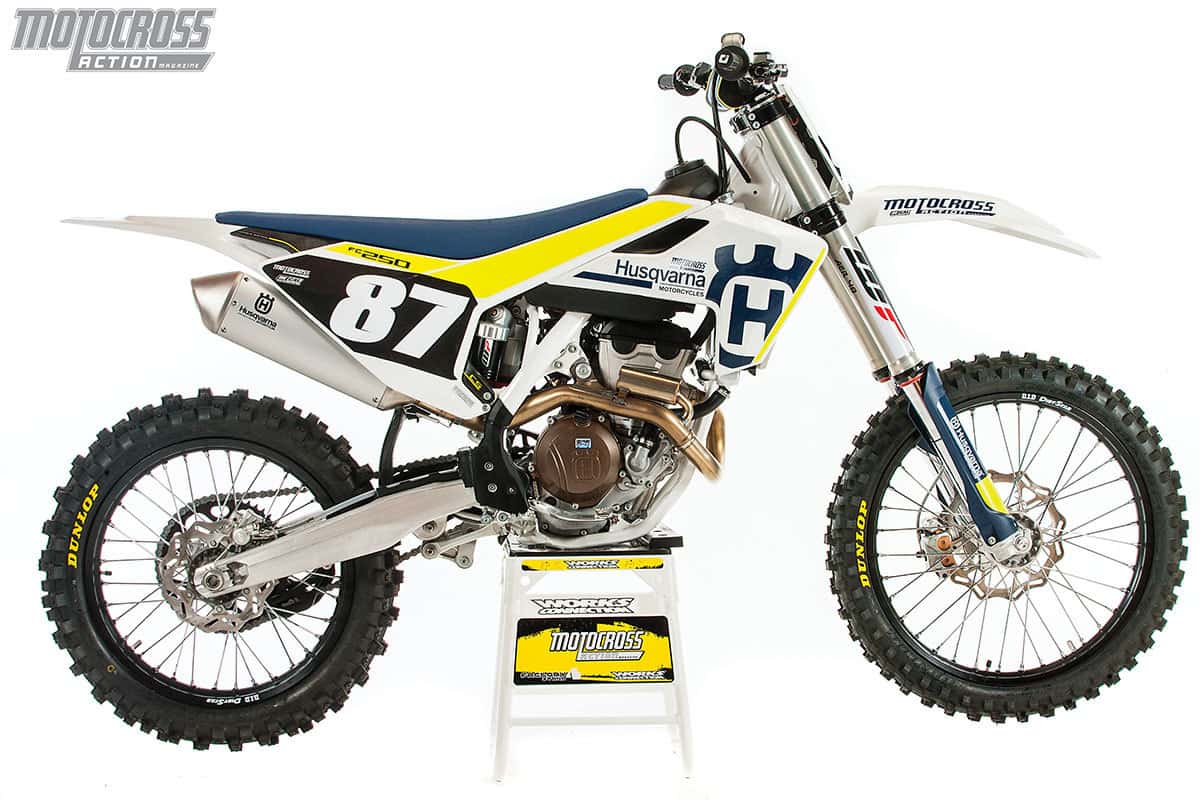
Q: WHAT IS PLATFORM SHARING?
A: Another name for platform sharing is badge engineering. Platform sharing is when a manufacturer uses major components from one brand as the basis for another. This can include engines, frames, suspension components, wheels and brakes. Platform sharing saves money, because the manufacturer gets the benefit of economy of scale. Instead of having to build new frames and engines for each of its vehicles, a company can make separate and inexpensive production runs of each and just label them differently.
The automotive industry is rife with platform sharing—the Audi A3, Audi Q3, Audi TT, VW Golf, VW Jetta, VW Eos, VW Tiguan, VW Touran, VW Scirocco, Seat Leon, Seat Toledo, Seat Altea and Skoda Octavia all ride on the same basic components. Don’t think that motorcycles have been immune to badge engineering. In the late ’60s, British rivals BSA and Triumph used platform sharing on lots of models, most famously on the BSA Rocket 3, which was also sold as the Triumph Trident. No matter the badge, both bikes rolled out of BSA’s Small Heath factory.
In motocross, the best-known example of platform sharing was the 2004 Kawasaki/Suzuki Alliance. In 2004 and 2005, the Kawasaki KX250F and Suzuki RM-Z250 were identical save for the yellow or green plastic.
Q: WHAT ARE THE NON-PLATFORM PARTS ON THE HUSKY FC250?
A: Platform sharing is crucial to Husqvarna’s continued existence. Equally crucial is stopping people, including the MXA wrecking crew, from calling Husqvarnas “white KTMs.” Consumers demand more than just a wig, beard and change of clothing from Husqvarna. They want something uniquely Husqvarnian. Are they getting it? We don’t think so. Here are eight areas where the Husky isn’t a KTM.
(1) Aesthetics. The Husqvarna’s overall look—from its truncated rear fender to its platypus-bill front fender to its white color scheme—is unique.
(2) Clutch. Unlike the KTM, which uses a Brembo clutch lever, master cylinder and slave unit, the Husqvarna uses Magura components.
(3) Carbon fiber subframe. Husqvarna’s subframe is plastic, with carbon particles mixed into the formula. It is technically 70 percent plastic and 30 percent carbon.
(4) Swingarm. Husqvarna’s swingarm has a different shape from the KTM swingarm.
(5) Rims. Husqvarna specs D.I.D. Dirt Star rims, while the KTM uses plain-wrap Takasago Excels.
(6) Brakes. Husqvarna uses GFK brake rotors and silver spokes. KTM uses Galfer rotors and powdercoated black spokes.
(7) Handlebars. The Husky FC250 is outfitted with Pro Taper bars with a proprietary Husqvarna bend. KTM uses Neken bars.
(8) Seat cover. Husqvarna’s seat cover is more aggressive than KTM’s rough-surface cover.

Q: WHAT CHANGES DID HUSQVARNA MAKE TO THE 2017 FC250?
A: There are nine major changes to the 2017 FC250 compared to the 2016 FC250. Here is the list.
(1) Air forks. WP AER front forks replace last year’s WP 4CS forks.
(2) Shock spring. Last year the 2016 Husqvarna FC250 came with the 45 N/m shock spring. This year the FC250 gets a more appropriate 42 N/m spring.
(3) Map switch. Gone is the flick-style selector switch, and in its place is a multi-switch that toggles between two maps, launch control and traction control.
(4) Brake pedal. The rear brake pedal is now 10mm longer than it was in 2016.
(5) Rear brake pads. The rear brake pads have a less aggressive compound to make the rear stopper less grabby.
(6) Head stays. Last year’s steel head stays have been replaced with thicker cast-aluminum stays that are 60 grams lighter.
(7) Triple clamp. The top triple clamp is more rigid.
(8) Hour meter. There is an hour meter installed on every Husqvarna.
(9) Handlebar clamps. Last year the bars were mounted to a one-piece lower bar mount, but for 2017, the top bar mount is one piece.

Q: HOW DOES THE 2017 HUSQVARNA FC250 RUN ON THE DYNO?
A: The 2017 Husqvarna FC250 makes a stunning 44.38 horsepower at peak, the most in the 250 class. Does that mean the Husky FC250 is faster than the 2017 KTM 250SXF? Yes, on a dyno. On the track, there is some doubt. The Husqvarna powerband pulls a little longer, with a steadier metronome-style power pulse, than KTM’s snappier, and is more responsive and a quicker-revving engine. In the saddle, you can feel the difference between the two. Every MXA test rider said that the KTM was faster.
If they are identical engines, why don’t they run the same? Husqvarna’s plastic airbox is different from the KTM’s. Our biggest complaint about the Husky airbox is that airflow is severely restricted by the molded design. During our dyno runs, we ran back-to-back tests with the airbox cover propped open 2 inches. The opened-up airbox made a 1/2 horsepower more at every point on the powerband. Peak horsepower jumped from 44.38 horsepower to 44.67 horsepower.
As for the 2017 numbers, the Husqvarna FC250 makes 44.38 horsepower. The KTM 250SXF makes 43.73 horsepower. The Yamaha YZ250F makes 40.98 horsepower. The Kawasaki KX250F makes 40.06 horsepower. The Honda CRF250 makes 38.89 horsepower, and the Suzuki RM-Z250 makes 38.34 horsepower.
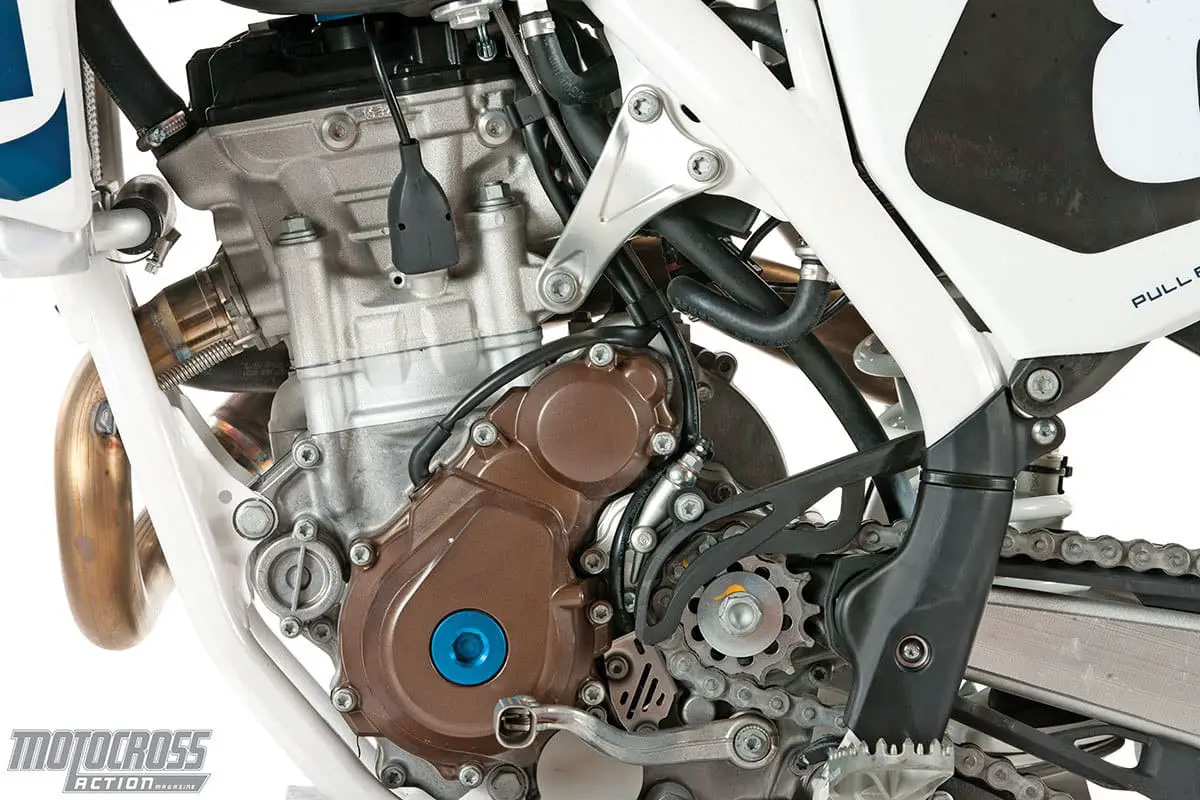
Q: HOW FAST IS THE 2017 HUSQVARNA FC250?
A: When we tested the 2017 KTM 250SXF in the November 2016 issue we said, “If you are talented, brave or stupid, this will be the fastest 250cc four-stroke you’ll ever race. If you are slow, the best strategy is to stick it in second gear and refuse to shift. That way, you’ll rev it to the moon but not have to dance on the precipice of disaster. This is a Pro powerband.”
Guess what? The Husqvarna also requires you to go to max rpm in virtually every gear. Unlike the KTM, however, the power below 14,000 rpm is more manageable because it has a less rushed response. It’s important to note that even though the Husky FC250 is a little easier to ride, it is still a top-end-only powerband. And just as with its orange brother, you have to use it to its fullest to get the most out of it. MXA test riders were split between the snappier KTM and steadier Husky, but regardless of which color you choose to buy, you can get the exact same power out of the Husqvarna as the KTM by simply drilling out the plastic airbox.
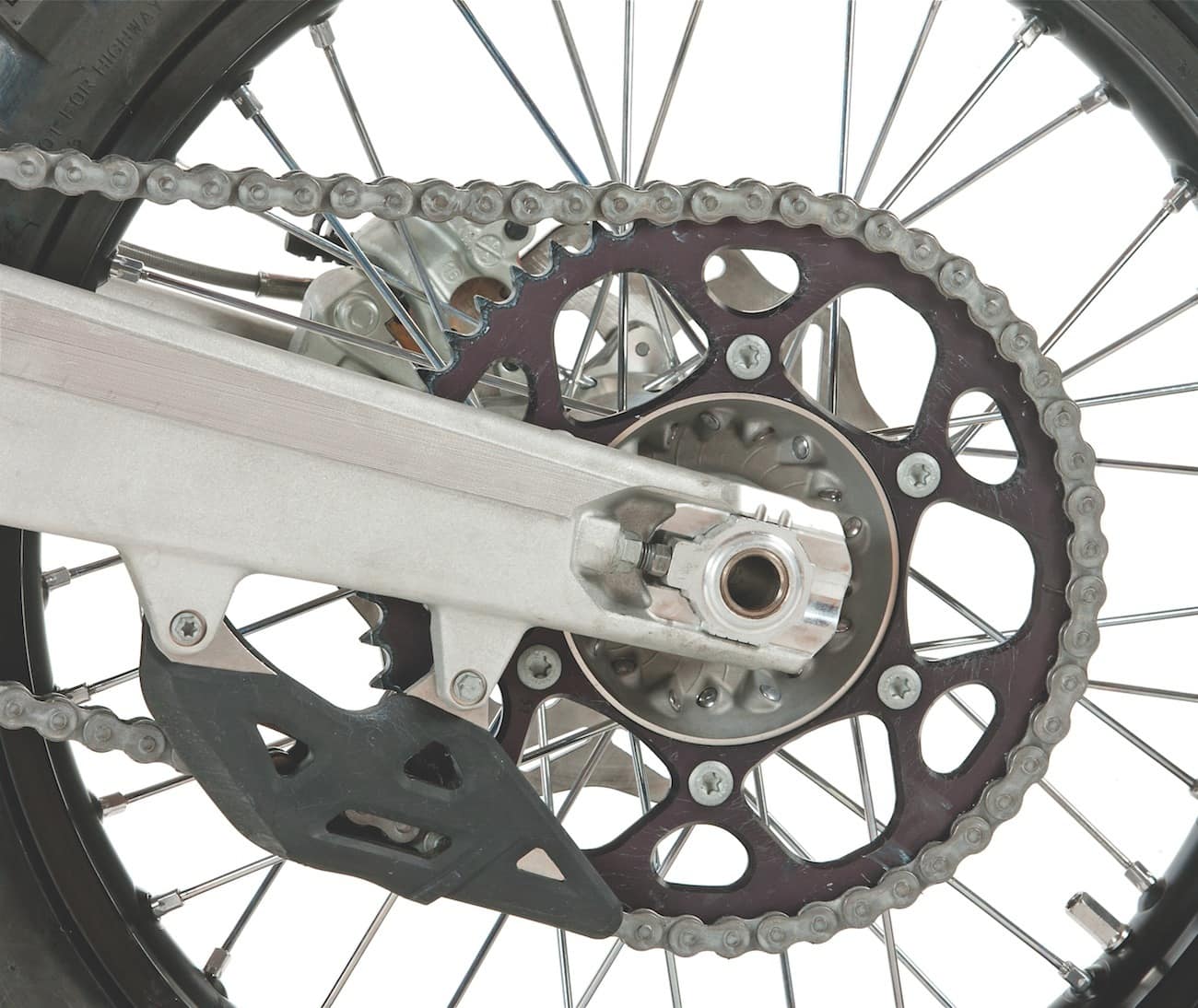
Q: WHAT ABOUT THE GEARING?
A: Depending on the track layout, many Novice and Vet riders had trouble getting the Husqvarna FC250 all the way to 14,000 rpm. They would run out of straight before they ran out of revs. The problem is that last year’s FC250 had 13/50 gearing; this year it has 14/51 gearing. This very tall gearing might work for a National Pro, but it is way too tall for a Novice, Vet or Beginner. You should leave the 51 on the rear and put a 13-tooth countershaft sprocket on the front. The tighter gearing will make it easier to get on the pipe sooner and develop enough thrust to get full use out of the high-rpm powerband.

Q: WHAT ABOUT THE MULTI-SWITCH?
A: The 2017 Husqvarna FC250 has a rubber-covered multi-switch on the left side of the bars that activates two maps (stock and aggressive), launch control and traction control. What were the best settings?
Map switch. Pressing the rubber-covered button on the bottom of the multi-switch lights up a number on the face of the multi-switch. Number one is stock and number two is aggressive. Every MXA test rider chose to run the aggressive map. It produced quicker throttle response and helped jump the power up to the midrange where it does its best work. There is no mellow map option.
Traction control. For 2017, Husqvarna offers on-demand traction control. How does it work? The ECU monitors runaway revs as an indicator of when the rear wheel is spinning. The computer compares the rpm’s arithmetical progression to its geometrical progression and retards the ignition when the two numbers are out of whack. In short, when the rpm goes haywire, the computer mellows out the power to stop the rear wheel from spinning. On hardpack dirt, pavement or clay-style mud, this was the cat’s meow, but it was irritating on prepped dirt, loam or sand. MXA test riders used traction control as the mellow map.
Launch control. To engage launch control, the racer must press the map button and the traction control button simultaneously until the indicator light behind the front number plate flashes. Once launch control is engaged, you must not allow the rpm to drop by more than 30 percent or launch control will shut off—and you cannot re-engage it without shutting the engine off. Let’s face it, this is a 250cc motocross bike. If you need launch control to get it off the line, you need to find a new sport.
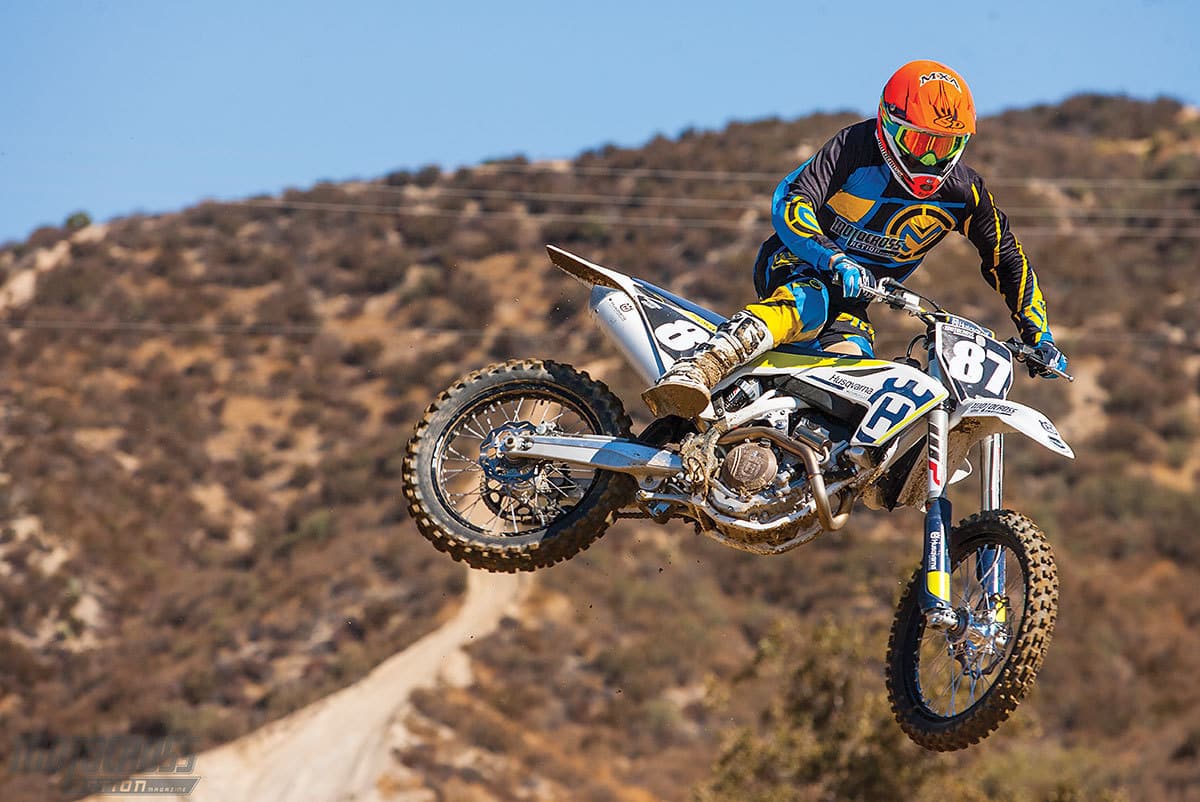
Q: HOW DOES THE 2017 HUSQVARNA FC250 HANDLE?
A: From a numbers point of view, the 2017 Husqvarna FC250 should handle identically to the 2017 KTM 250SXF, but, it doesn’t. There are two reasons every MXA test rider felt that the twins were different. (1) Husqvarna’s three-piece plastic airbox is more resilient than KTM’s standard-issue aluminum tube structure. The flexier feel of the plastic makes the Husqvarna feel plusher and softer when landing from jumps or under heavy torsional loads in corners. (2) The Husky’s slightly mellower power delivery, which develops over a longer time, has the effect of slowing down reaction times for more overall control. Both the KTM and the Husky handle like dreams, but most MXA test riders preferred the plusher feel of the Husqvarna.
Q: WHAT DOES IT WEIGH?
A: The 2017 Husqvarna FC250 hits MXA’s amazingly accurate scales at 220 pounds sans gas. That is 2 pounds more than the KTM 250SXF (blame the molded airbox and beefier brake rotors). It is the second lightest 250 four-stroke made.
Q: HOW GOOD ARE THE 2017 WP AER FORKS?
A: Kudos to Yamaha. Say what? When Honda, Yamaha, Suzuki and Kawasaki embraced air-fork technology, Yamaha stuck with its old-school, coil-spring Kayaba SSS forks. This turned out to be important for the motorcycle industry, because it made it difficult for Showa SFF TAC air forks or Kayaba PSF air forks to be shoved down the consumers’ throats. Yamaha made everyone realize that the emperor had no clothes. By proving that 11-year-old coil-spring forks were better than the whiz-bang, high-tech, brand-new air forks, Yamaha forced every racer to re-evaluate what he really wanted from his front forks.
What does this have to do with WP’s new AER air forks? A lot. WP was able to sit back and watch as Honda, Suzuki and Kawasaki foisted different air-fork contraptions on consumers with each new model year, while Yamaha stood pat with what worked before. WP’s engineers knew that if they came out with an air fork and they wanted an air fork to dovetail into their massive weight-loss program, they needed it to be very good, very simple and very uncomplicated. They didn’t want to make the same mistakes that Showa and Kayaba had made by building Rube Goldberg designs that made consumers angry.
WP’s AER air forks are ingenious in their simplicity. They have an air cartridge, similar in concept to a bicycle pump, in the right fork leg. There is only one Schrader valve on the AER forks, not three as on the SFF TAC forks. Since the air takes the place of the two coil springs in the previous WP 4CS forks, the weight savings is 3.6 pounds. All the damping is handled by the left fork leg via one compression clicker and one rebound clicker (they don’t have four different clickers like the Kayaba PSF-2 forks). Setup is simple. Find the proper air pressure for your speed and then click in your favorite compression and rebound settings.
You can race these forks right off the showroom floor, and you don’t need an iTunes app to make sense of how they work. Good stuff.
Q: WHAT DID WE HATE?
A: The hate list:
(1) Gas cap. It sticks. We’ve had test riders who couldn’t get it off at the gas station.
(2) Exhaust. Removing the stock exhaust requires several annoying steps, including removing the shock.
(3) Sprocket and spokes. Watch the sprocket bolts and the rear spokes for as long as you own the bike.
(4) Shock collar. Nylon is for bathing caps, not preload rings.
(5) Torx bolts. You can’t bleed the forks without a #20 Torx wrench or remove the ODI lock-on grip or right side panel without a #10. Even the brake and clutch master-cylinder caps are held on with Torx bolts.
(6) Spacers. There are spacers in the seat-bolt hole and right side panel that fall out when you remove either of these two bolts. Shouldered bolts or tolerance-fit spacers would have solved this problem. We used grip glue.
(7) Heat shield. We had to double up the heat shield on the side panel to stop the pipe from melting through it.
(8) Airbox. Why do Husqvarna’s engineers keep building airboxes that don’t breathe.
(9) Gearing. Exchange the tall 14-tooth countershaft sprocket for a lower 13.
Q: WHAT DID WE LIKE?
A: The like list:
(1) Weight. It’s not the lightest 250 four-stroke, but it is the second lightest at 220 pounds.
(2) Tires. Last year the Husqvarna FC250 came with Dunlop MX52 tires. This year it has MX3S tires. They’re very good sneakers.
(3) Electronics package. The new multi-switch gives the rider a choice between two maps (we always ran the aggressive map), launch control (which we only used on concrete or hardpack), and traction control (which we used in place of last year’s mellow map).
(4) Air filter. The world’s greatest air-filter design.
(5) Hydraulic clutch. This clutch is durable enough to last in the hands of a clutch abuser.
(6) Power. A few years ago works bikes made 40 horses. The stock 2017 Husqvarna FC250 makes 44 horses.
(7) Hour meter. The best thing about the showroom-stock Husqvarna hour meter is that they put it on for you.
(8) AER forks. We would have been happy just to get forks that worked better than the 4CS forks, but the AER forks are the best air forks on the track.
Q: WHAT DO WE REALLY THINK?
A: We would be remiss if we didn’t say that the 2017 Husqvarna FC250 is basically for people who don’t like orange.
MXA’S HUSQVARNA FC250 SETUP SPECS
This is how we set up our 2017 Husqvarna FC250 for racing. We offer it as a guide to help you find your own sweet spot.
WP AER FORK SETTINGS
The trick to getting the most from your AER air forks is to find the proper air pressure for your weight, speed and track. In the case of the 2017 Husqvarna FC250, we think that the stock 154-psi air pressure is at the top of the scale and that most riders should work down from there. How far down? We’ve gone as low as 130 pounds, but we typically start testing at the OEM-recommended air pressure, and then lower it in 2-psi increments until the forks don’t feel like they are dropping into their stroke. Typically, AER forks ride high in their stroke with the stock pressure. It’s important to note that any recommended air-fork setting is totally dependent on the weight and speed of the rider. As a rule of thumb, MXA doesn’t choose its settings for Pro riders; Pros favor jackhammer settings that can’t be used by the vast majority of motorcycle riders. For hardcore racing, we recommend this fork setup on the 2017 Husqvarna FC250 (stock specs are in parentheses):
Spring rate: 140 psi (154 psi)
Compression: 20 clicks out (12 clicks out)
Rebound: 15 clicks out (12 clicks out)
Fork-leg height: Third line
Notes: It is possible that some racers won’t get full travel no matter how low they set the air pressure. In that case, we suggest lowering the oil height in the damping leg by 10mm or more to get full travel. Additionally, MXA test riders pay very close attention to how the forks ride on the track, avoiding having the fork ride too low or too high in its stroke. We bleed the outer chamber on the air side constantly, which is accessed via a 10mm hex head or #20 Torx. Even if you own a #20 Torx, don’t use it, because the bleed screw strips out easily. On the damping side, we change the bleed screw from a Torx to the previous Phillips-head design.
WP SHOCK SETTINGS
Last year the Husqvarna FC250 came with a stiff 45 N/m shock spring. This really wasn’t the best spring rate for the typical 140-pound 250 four-stroke racer, especially given that most MXA test riders ran a 45 N/m spring on their 2016 450SXFs — and that is what Husqvarna spec’ed for the FC450 for 2017. For 2017, Husqvarna lowered the shock spring rate to a 42 N/m. This is a big improvement for the FC250’s target audience. For hardcore racing, we recommend this shock setup for the 2017 Husqvarna FC250 (stock specs are in parentheses):
Spring rate: 42 N/m
Race sag: 105mm (110mm)
Hi-compression: 2 turns out
Lo-compression: 15 clicks out
Rebound: 10 clicks out (15 clicks out)
Notes: As a rule of thumb, we use the high-speed compression to iron out the balance of the rear suspension, typically varying by a 1/4 turn in either direction. Our biggest change is to the rebound damping, which we think is too fast in consecutive bumps. Additionally, we set the sag at 105mm instead of the WP-recommended 110mm.
MXA’S FIRST RIDE! 2017 HUSQVARNA FC250




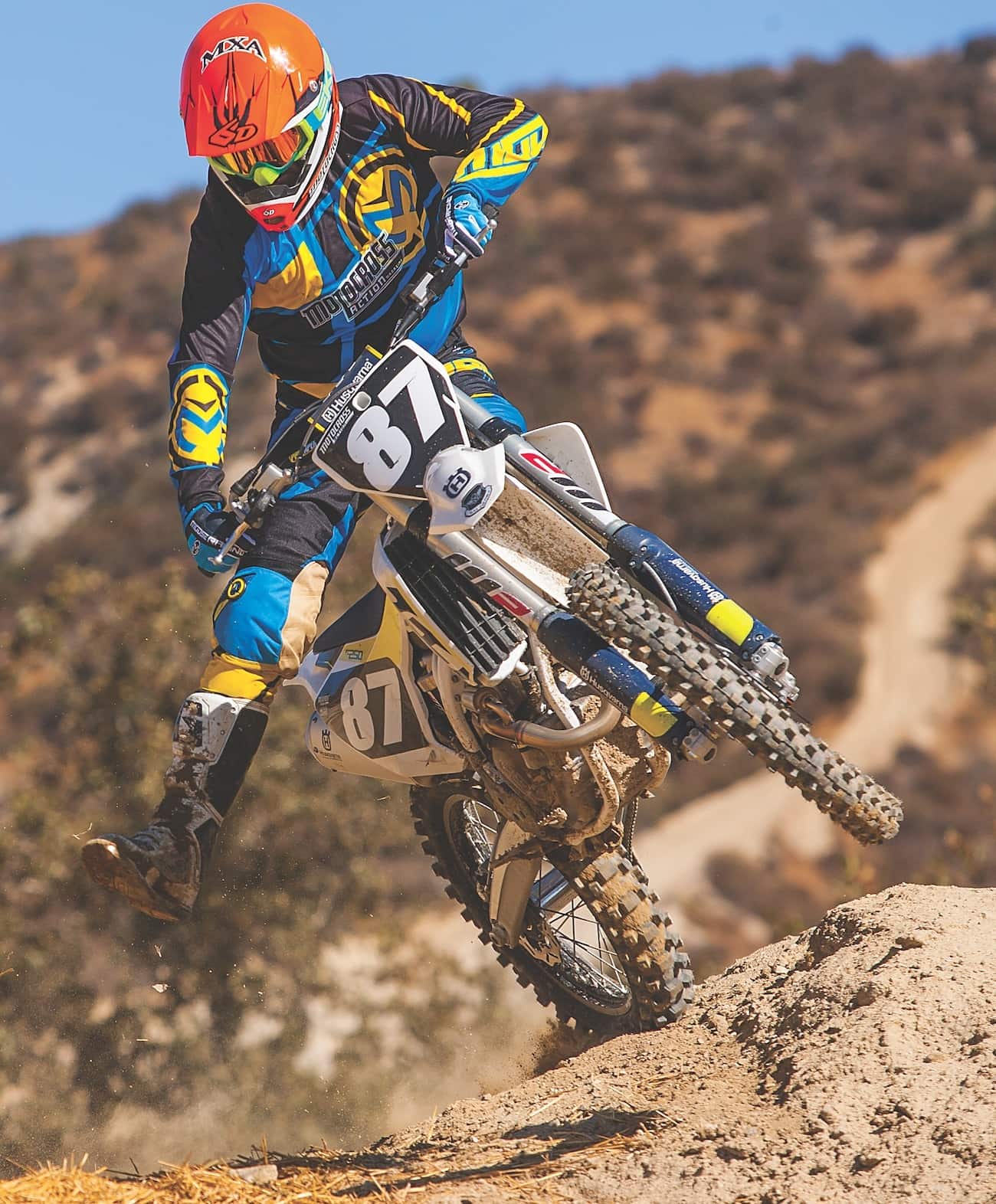

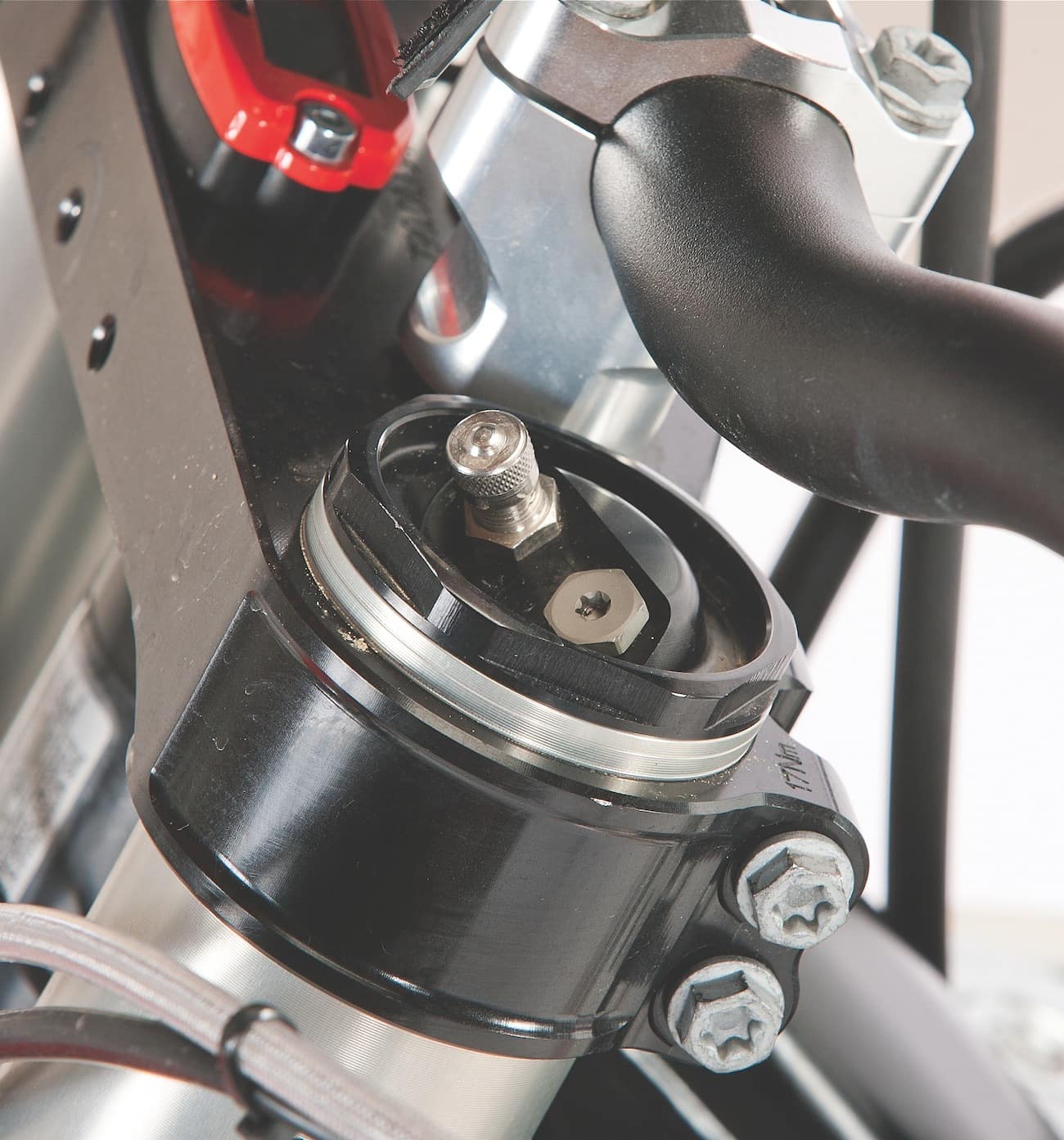
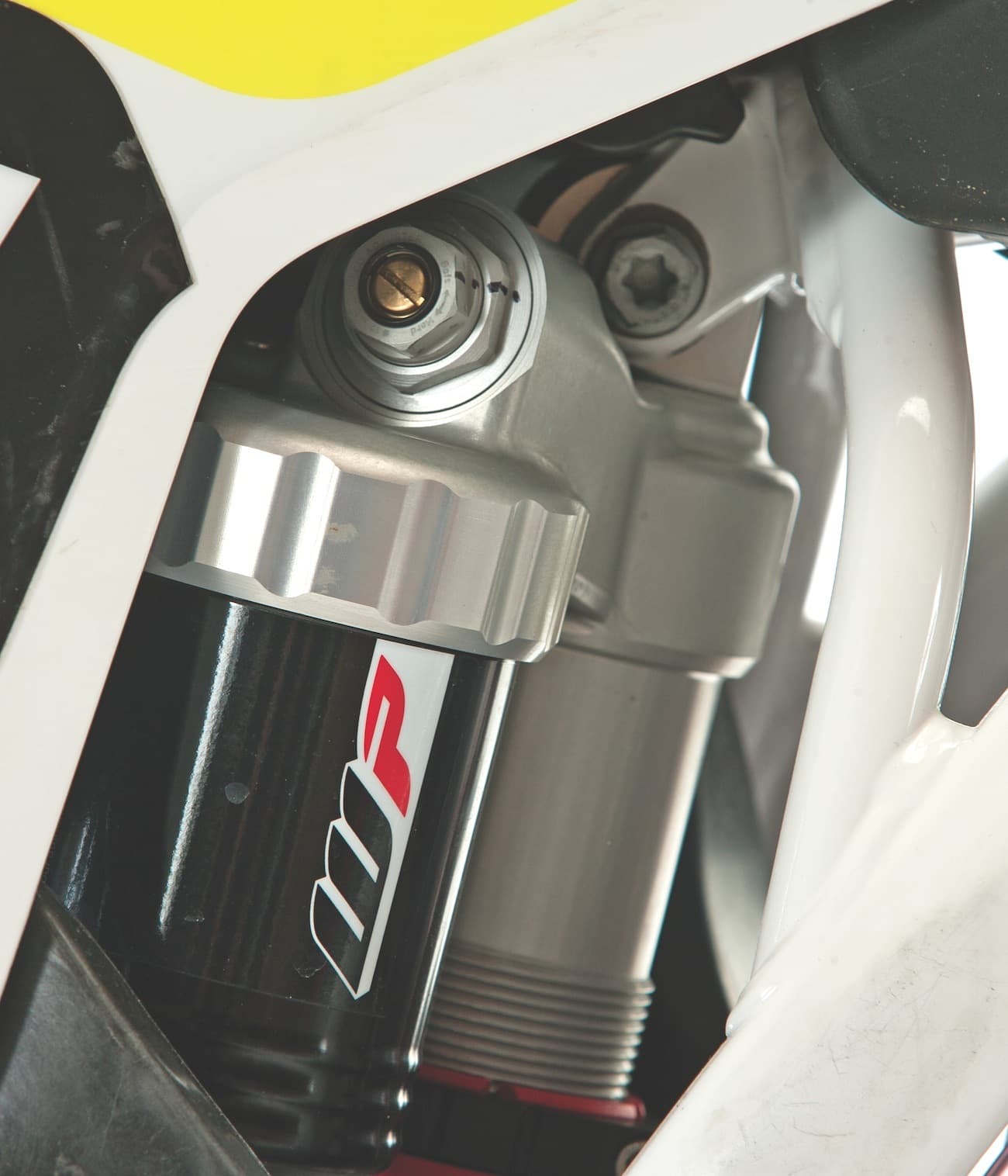



Comments are closed.